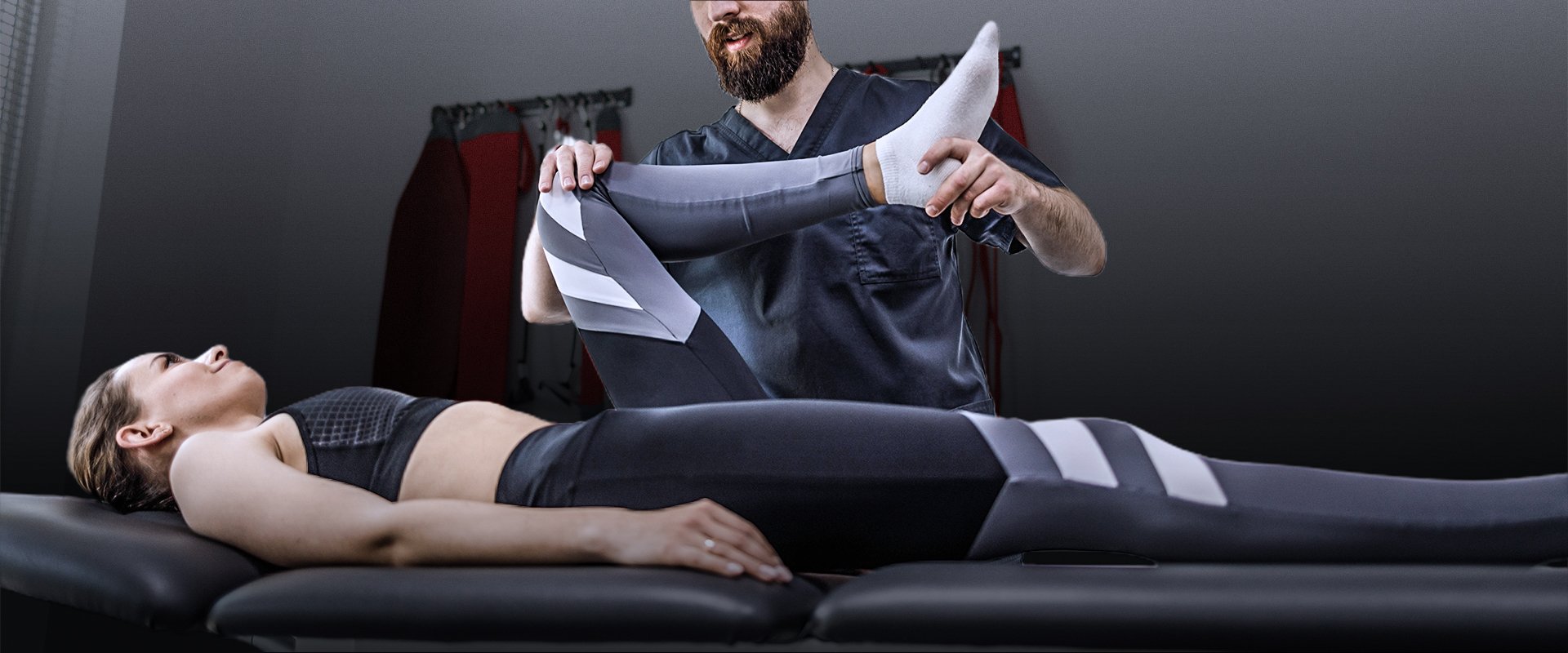
Physical Therapy for Piriformis Syndrome
AT EVOLVE
Physical Therapy for Piriformis Syndrome
HOW CAN PHYSICAL THERAPY TREAT PIRIFORMIS SYNDROME?
Piriformis syndrome is a musculoskeletal condition characterized by pain in the buttock or hip caused by compression of the sciatic nerve–one of the largest nerves in the body–by the piriformis muscle. Physical therapy is a first line treatment for piriformis syndrome and can help manage symptoms, address underlying factors and prevent recurrence.
WHAT DOES PHYSICAL THERAPY FOR PIRIFORMIS SYNDROME LOOK LIKE?
Like with all conditions, we will begin with an initial evaluation to better understand the pattern of symptoms you are experiencing as well as your goals and needs. We will ask about the activities within your life that are being impacted by these symptoms as well as about your health history. We will then perform a physical exam focusing on the involved area including assessing, strength, range of motion, flexibility, soft tissue mobility and more. We will also observe you performing functional tasks like walking, running or going down a step. With this information we can create an individualized treatment plan to address your symptoms. Your treatment program may involve hands-on manual therapy techniques performed by your therapist as well as movements and exercises performed by you in the clinic and at home.
HOW LONG WILL I NEED PHYSICAL THERAPY?
The duration of your physical therapy plan of care will vary depending on the severity of symptoms and the underlying factors which are being addressed in therapy. While full resolution of symptoms can take some time, you may begin to see some results right away. You should experience improvements in many symptoms such as pain, stiffness, and inflammation within a couple of weeks. Progression in strength, flexibility and overall mobility that allows you to return to your prior level of unrestricted activity, may take longer. Achieving long lasting results may take some time, but dedication to your program will not only help you achieve these results but will help to decrease the likelihood of symptoms recurring in the future.
WHAT IS PIRIFORMIS SYNDROME?
The piriformis muscle is a small, pyramidal-shaped muscle deep in the buttock near the center. It arises from the front side of the sacral bone at the base of the spine and extends across the buttock to attach at the top of the femur near the hip. It lies beneath the biggest gluteal muscle called the gluteus maximus. This muscle is a rotator of the hip. It rotates the hip internally or externally depending on the position of the hip. It also helps with stability at the hip.
The sciatic nerve is a bundle of nerve fibers that originate from the base of the spine and innervates many of the leg and foot muscles. Generally this nerve runs just beneath the piriformis muscle exiting the pelvis below the belly of the muscle but anatomical variations exist wherein the nerve travels over or through the muscle belly of the piriformis and sometimes even splits around it. When piriformis syndrome is thought to be caused by these anatomical anomalies of nerve orientation it is called primary piriformis syndrome but it is unclear how often these variations in nerve position actually cause symptoms.
The most common type of piriformis syndrome occurs due to compression of the sciatic nerve by the piriformis muscle. This can occur due to several causes of which the most common include:
- Spasm or inflammation of the soft tissue around the buttocks due to trauma
- Muscle spasms of the piriformis following back surgery
- Piriformis muscle spasms due to lumbar or sacral joint pathology
- Piriformis muscle spasms due to overuse
- Shortening of the piriformis muscle due to biomechanical factors which compresses or irritates the sciatic nerve
- Pain felt deep in the buttocks
- Numbness in the buttock or down the leg
- Persistent low back pain that may be radiating
- Paresthesias/tingling or abnormal sensations in the buttock or leg
- Pain with prolonged sitting
- Tenderness to palpation over the area
- Increased pain after activities like stair climbing, bending, squatting or walking
End Injury Progression
Physical therapy for Piriformis Syndrome has proven to prevent injury, slow and even stop pain issues, improve performance, and reverse injury progression in many cases.
Relieve Pain
The movements used in this technique can target your entire body helping you to manage discomfort and pain during the course of your physical therapy treatments.
Improve Range of Motion
Posture awareness is an important area to focus on due to the fact that certain positions may cause you further discomfort and pain.
Restore Mobility
You can regain mobility and flexibility by taking part in the stretches and exercises as prescribed by your physical therapist.
How Long Will Physical Therapy for Piriformis Syndrome Last?
PHYSICAL THERAPY INTERVENTIONS FOR PIRIFORMIS SYNDROME
Conservative treatment for piriformis syndrome is the first line approach. This may include pharmacological treatments like NSAIDs or muscle relaxers and almost always physical therapy. Treatments for piriformis syndrome will always be individualized to address a patient’s impairments but several physical therapy interventions have been shown to be helpful in the management of this condition:
Lifestyle modification: lifestyle modification to reduce compression or irritation of the sciatic nerve can be helpful in reducing symptoms. Avoiding sitting for prolonged periods and daily stretching for example are often recommended.
Modalities: modalities like ultrasound, hot or cold therapy can be utilized to reduce inflammation, promote tissue healing and reduce pain and spasms which may be beneficial early on in a treatment session.
Manual therapy: addressing myofascial restrictions, trigger points and other restrictions in soft tissue around the glutes may be important to address your symptoms. Your therapist may perform these interventions using their hands or may employ other tools like dry needling, foam rolling or IASTM.
Stretching: stretching of the piriformis muscle can address muscle length issues and may help alter pain sensations and decrease muscle spasms to reduce compression on the sciatic nerve.
Lumbar and sacral spine-focused treatments: your therapist may direct their treatment to the spine itself if they feel this is a contributing factor to symptoms. Manual therapy techniques and exercises may be prescribed to address these impairments.
Muscle strength and performance exercises: if biomechanical factors are thought to be contributing to piriformis syndrome your therapist may prescribe a series of functional hip and gluteal strengthening exercises to ensure the small piriformis muscle isn’t trying to do the work of these larger muscles.
Functional training and restoration of activity: as underlying factors are addressed and symptoms subside, your therapist will incorporate more functional activities to ensure proper biomechanics, motor control and coordination when performing these activities. They will also educate you on how to return to your prior level of activity with an eye on prevention of piriformis syndrome in the future.
The symptoms of piriformis syndrome can surely be a pain but you should feel confident that the physical therapists at Evolve Physical Therapy know how to help. Call today to schedule an initial evaluation.
Mill Basin (located in Harbor Fitness)
6161 Strickland Ave
Brooklyn, NY 11234
Monday: 7am-8pm
Tuesday: 7am-8pm
Wednesday: 8am-5pm
Thursday: 7am-8pm
Friday: 8am-1pm
Park Slope (located in Harbor Fitness)
550 5th Ave.
Brooklyn, NY 11215
Monday: 9am-8pm
Tuesday: 8am-6pm
Wednesday: 9am-8pm
Thursday: 8am-6pm
Friday: 8am-3pm
Gravesend
372 Avenue U
Brooklyn, NY 11223
Monday-Thursday: 8am-8pm
Friday: 8am-3pm
Kings Highway
945 Kings Highway
Brooklyn, NY 11223
Monday-Wed.: 12pm-8pm
Ready to take the next step to a healthier you?
Contact Us Today!
PHYSICAL THERAPY FOR PIRIFORMIS SYNDROME!
Need physical therapy for Piriformis Syndrome?
Let our caring and compassionate physical therapists help you with relieving pain while getting you back on your feet comfortably.
Call now to schedule your first PT consultation free of charge.
Call: 1-718-258-3300







